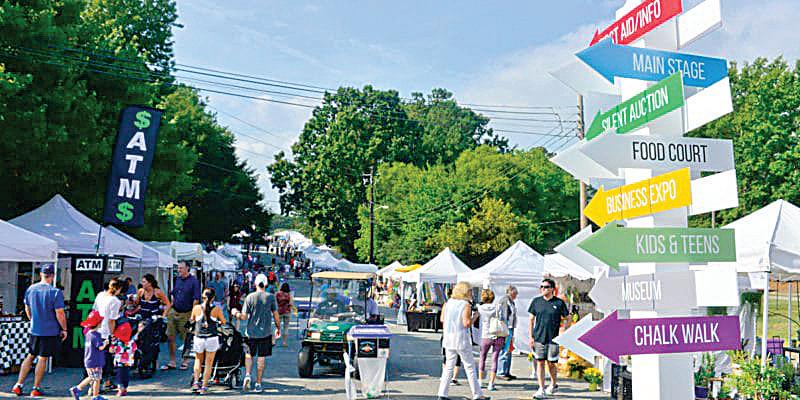
4 minute read
Five Roadside Wonders in North and Central Georgia
By Joe Earle
Georgia offers an array of amazing attractions. Our state provides the natural beauty of beaches and mountains, waterfalls and canyons. But the wonders don’t stop there. Georgia serves up its share of manmade marvels, too.
Here are a few favorites among the strange sights that stand along north Georgia roads. Some express their makers’ deepest feelings. Others seem to have been conjured simply to amuse casual passersby. Whatever their reason, they’re out there.
The Georgia Guidestones
The Guidestones, sometimes described as an “American Stonehenge,” appeared in this out-of-theway hilltop in Elbert County in the 1970s. It stands nearly 20 feet tall, works as an observatory, and is inscribed with advice to the people of Earth in eight modern languages (Arabic, Chinese, English, Hebrew, Hindi, Russian, Spanish and Swahili) and several ancient languages (including Sanskrit and Babylonian).
A local granite company built the monument, supposedly to the specifications of a mysterious visitor who called himself “R.C. Christian.” The Guidestones — which have been praised by some and attacked as demonic by others — now are so well known that they have their own Wikipedia page.
Where it is: Guidestone Road, N.W., Dewy Rose 30634
How to get there: Take I-85 North to Ga. 51 East (Exit 160). Take Ga. 51 to Ga. 145. Continue on U.S. 29 North. Turn right on Clay Brown Road, which becomes Bio Church Road. Turn right onto Ga. 77 South (Elberton Highway). Turn left onto Guidestone Road.
Paradise Garden
Folk artist Howard Finster created visions of paradise at his north Georgia home. Finster started work on his garden in 1961, according to the Paradise Garden Foundation website, and there, in 1976, he had a vision that he should paint and produce sacred art. He created more than 46,000 works (he numbered them) before his death in 2001. His garden, a labyrinth of paths and structures he made from recycled objects such as bicycle parts or tools, now is operated by the foundation and is open for visits Tuesdays through Sundays from 11 a.m. to 5 p.m., and Sundays from 1 to 5 p.m. There is an entrance fee: $10 for seniors, $15 for adults and $5 for students, according the website, paradisegardenfoundation.org.

Where it is: 200 N. Lewis Street, Summerville 30747
How to get there: Take I-75 North to Ga. 140 (Exit 306). Take Ga. 140 West to Ga. 1/U.S. 27 (the Martha Berry Highway). Turn right and take Ga. 1/U.S. 27 through Summerville. Turn right on Rena Street. Take the third right onto North Lewis Street.
Pasaquan

Eddie Owens Martin, sometimes known as “St. Eom,” transformed his home in the little west Georgia town of Buena Vista into a place like no other in the world, perhaps like no other in this galaxy. With concrete and bright paint, Martin added walls and outbuildings, sculptures of giant heads, painted mandalas and portraits of folks who could fly. RoadsideAmerica.com describes Pasaquan as “equal parts mysticism, geometry and snake handling.” It now is owned by Columbus State University and is open Fridays, Saturdays and Sundays, except for federal holidays and the months of July and December. It’s open from 10 a.m. to 5 p.m. Contributions of $5 for seniors, $10 for adults and $3 for students are recommended. More at pasaquan.columbusstate.edu.
Where it is: 238 Eddie Martin Road, Buena Vista 31808
How to get there: Take I-85 South to I-185. Take I-185 to U.S. 280. Take U.S. 280 East to Ga. 26. Take Ga. 26 into the town of Buena Vista. From the Buena Vista town square, drive north 1.4 miles on Ga. 41, then turn left onto Ga. 137. Go west 4.4 miles on Ga. 137 and take a right onto Eddie Martin Road, then 0.4 miles north to 238 Eddie Martin Road.
The Iron Horse
This metal sculpture of a horse stands tall (10-plus feet) in a field in central Georgia like some giant abstract scarecrow. It surveys the landscape, its hindquarters turned toward Athens, home of the University of Georgia, where it was made and shunned.
University officials briefly displayed the sculpture on campus in 1954, but students, apparently not ready to accept abstract art, defaced it with spray paint and balloons, and tried to set it on fire. University officials quietly removed the horse and kept it in a secret hideaway. Five years later, it appeared on this farm north of Greensboro, where, head held high, it has stood since.


Where it is: On Ga. 15, Watkinsville 30677, north of Greensboro





How to get there:
Take I-20 East to Ga. 44 (Exit 130). Go north on Ga. 44 into Greensboro. Take Ga.
15 North toward Watkinsville; after you cross the Oconee River, look for the statue in a field on the right side of the road. The statue stands on private property, but usually can be seen clearly from the road.
Pig Hill of Fame

This hillside display of affection for little wooden piggies got its start in the 1980s when barbecue restaurant owner Oscar Poole decided he needed to draw attention to his roadside eatery. Poole put up signs shaped like pigs, and soon customers were paying $5 apiece to have their names painted on a wooden pig and added to the porcine display. There now are hundreds of colorful pigs staked on the hill behind the restaurant. Poole’s place has become something of a draw in Republican Party circles — the names of a number of prominent Republican officeholders appear on pigs – and claims visits from celebrities ranging from radio and TV personalities to Miss America.

Where it is: 164 Craig St., East Ellijay 30540



How to get there: Take I-75 North to I-175/Ga. 5 North. Continue on Ga. 515 East to East Ellijay. Turn right on Cross Street and then right on Craig Street.










